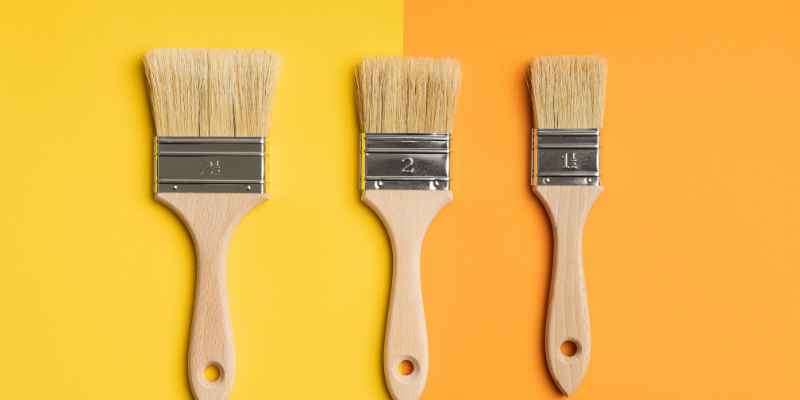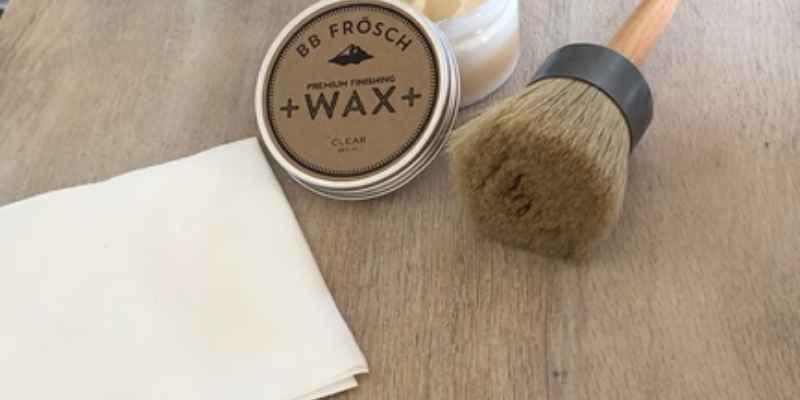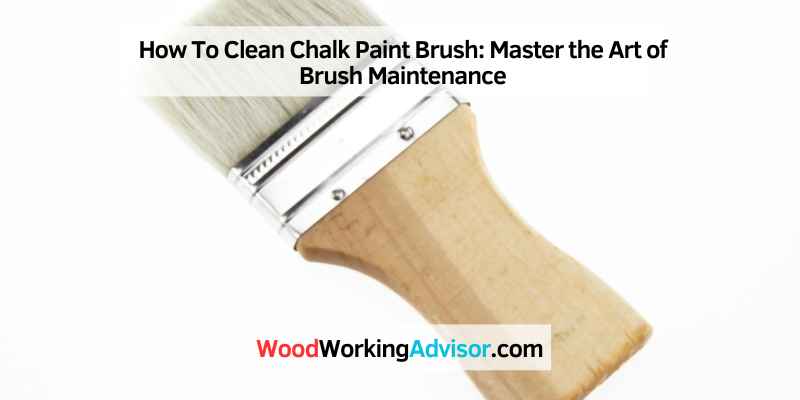To clean a chalk paint brush, rinse it thoroughly with warm water and mild soap. After rinsing, gently comb through the bristles to remove any remaining paint residue and lay it flat to dry.
Properly cleaning your chalk paint brush is essential to maintain its quality and prolong its lifespan. Neglecting to clean your brush can result in dried and hardened paint, making it difficult to achieve smooth and even brush strokes in your next painting project.
We will share a simple and effective method to clean your brush, ensuring its longevity and optimum performance. By following these steps, you can easily remove all traces of chalk paint, preserving the integrity of your brush for future use.
Why Cleaning Chalk Paint Brushes Is Important
Properly cleaning chalk paint brushes is crucial for maintaining their quality and ensuring optimal performance.
Failure to clean and care for these brushes can lead to a shortened lifespan and color contamination issues.

Tools And Materials You Will Need
When it comes to cleaning your chalk paint brush, having the right tools and materials is essential. Ensuring you have everything you need beforehand will help make the process quicker and more efficient. Below are the essential items you will need:
Warm Water
To effectively clean your chalk paint brush, you will need warm water. Fill up a bucket or sink with warm water that is comfortable to the touch.
Mild Soap
Using a mild soap is crucial in keeping your chalk paint brush clean without damaging the bristles. Look for a gentle, chemical-free soap that is suitable for cleaning delicate materials.
Soft Bristle Brush
A soft bristle brush is perfect for gently removing any excess paint from your chalk paint brush. It will avoid damaging the bristles and help maintain the brush’s integrity.
Clean Cloth
Having a clean cloth, such as a microfiber cloth or an old t-shirt, is necessary for wiping down the brush after it has been rinsed. It will help remove any remaining residue or soap.
Brush Conditioner
Using a brush conditioner can be beneficial in maintaining the longevity and quality of your chalk paint brush. It helps keep the bristles soft and pliable, ensuring optimal performance with each use.
Step-by-step Guide To Cleaning Chalk Paint Brushes
Cleaning your chalk paint brushes is essential to maintain their quality and extend their lifespan. A dirty brush can affect the application of your paint and can lead to undesirable results. In this step-by-step guide, we will walk you through the process of cleaning your chalk paint brushes effectively.
Remove Excess Paint
The first step in cleaning your chalk paint brush is to remove any excess paint. Gently tap the brush against the side of the paint can or a disposable surface to get rid of the majority of the paint. This will prevent the paint from drying on the brush’s bristles and make the cleaning process easier.
Prepare A Cleaning Solution
Next, prepare a cleaning solution to remove any remaining paint residue from the brush. Fill a container with warm water and add a few drops of mild dish soap. Swirl the water gently to create a soapy mixture that will help break down the paint.
Soak The Brush
Place the chalk paint brush into the container, ensuring that the bristles are fully submerged in the cleaning solution. Allow the brush to soak for about 10 minutes. This will loosen any dried paint and make it easier to clean.
Gently Clean The Bristles
After soaking, remove the brush from the cleaning solution and gently squeeze the bristles to remove any excess water. Use your fingers to massage the bristles, working the soap into the brush. This will help to loosen any stubborn paint particles. Be careful not to apply too much pressure as it may damage the bristles.
If necessary, you can also use a soft-bristled brush or a toothbrush to gently scrub the bristles. This will help to remove any remaining paint or debris. Rinse the brush under running water to remove the loosened paint and soap.
Rinse And Repeat If Necessary
Once the brush is thoroughly cleaned, rinse it under running water to remove any remaining paint and soap residue. Repeat the process if necessary until the water runs clear from the bristles. This ensures that all the paint is completely removed from the brush.
Dry And Condition The Brush
After rinsing, gently squeeze the bristles again to remove excess water. Use a clean cloth or paper towel to blot the brush and soak up any remaining moisture. Then reshape the bristles and lay the brush flat on a clean surface to dry. Avoid drying the brush upright as it can cause the bristles to become misshapen.
Once the brush is dry, you can condition the bristles to keep them soft and supple. Apply a small amount of brush conditioner or hair conditioner to the bristles and massage it in with your fingers. This will help to prevent the bristles from becoming stiff and prolong their lifespan.
By following this step-by-step guide, you can ensure that your chalk paint brushes are clean and ready for your next painting project. Proper brush maintenance is key to achieving beautiful results and preserving the longevity of your brushes.
Tips For Maintaining Chalk Paint Brushes
Maintaining your chalk paint brushes is essential to ensure their longevity and optimal performance. Learn how to clean chalk paint brushes effectively with these helpful tips.
Clean Brushes After Each Use
Properly cleaning your chalk paint brushes after each use is crucial for maintaining their quality and prolonging their lifespan. Leaving paint to dry on the bristles can make them stiff and ineffective for future use. To clean your brushes, follow these simple steps:
- Rinse the brush under lukewarm water to remove any excess paint. Gently massage the bristles to help loosen the paint particles.
- Use mild soap and water to create a soapy mixture. Swirl the brush in the mixture, ensuring that all bristles are thoroughly coated.
- Rinse the brush under running water until the water runs clear and all soap residue is removed.
- Pat dry the bristles with a clean cloth or paper towel, reshaping the brush as needed. Avoid squeezing or twisting the bristles, as this can damage the brush’s shape.
Store Brushes Properly
Properly storing your chalk paint brushes is essential to prevent damage and maintain their shape. Here are some tips for storing your brushes:
- Hanging your brushes upside down is an effective way to prevent the bristles from becoming misshapen. You can use hooks or clips to hang them from a rod or a hanger.
- Keep them in a container with the bristles facing up to avoid crushing or bending the bristles. This can be a cup, jar, or brush holder specifically designed for this purpose.
- Protect the bristles by covering them with a plastic brush cover or a breathable fabric pouch to shield them from dust and damage.
Reshape Brushes
Reshaping your chalk paint brushes is essential to maintain their effectiveness and ensure smooth application. Follow these steps to reshape your brushes:
- While the bristles are still damp from cleaning, gently reshape them with your fingers. Use a light touch to avoid damaging the bristles.
- Tap the brush gently on a hard surface to remove any excess water and to help the bristles regain their original shape.
- Leave the brushes to dry naturally in a well-ventilated area, ensuring that they are not exposed to direct sunlight or heat sources.
Avoid Excessive Pressure
Using excessive pressure when applying chalk paint with your brush can cause damage to both the bristles and the painted surface. To avoid this, follow these guidelines:
- Apply gentle pressure when loading your brush with paint. Avoid pushing the bristles too hard into the paint container, as this can cause them to splay or bend.
- Use light and even strokes when applying the paint to your desired surface. Applying too much pressure can lead to streaks or uneven application.
Avoid Harsh Solvents
Harsh solvents can damage the bristles of your chalk paint brushes, causing them to become frayed or discolored. It’s best to avoid using harsh solvents when cleaning or thinning your chalk paint. Instead, opt for mild soap and water for cleaning and water-based mediums for thinning, as they are gentler on the brushes.

When To Replace Chalk Paint Brushes
Keeping your chalk paint brushes in good condition is crucial for achieving flawless and professional results. But no matter how well you clean and care for your brushes, there will come a time when they need to be replaced. Here are the top reasons why you should consider replacing your chalk paint brushes.
Damaged Bristles
One of the primary signs that it’s time to replace your chalk paint brush is when the bristles become damaged. Over time, the bristles can wear down, fray, or become matted, resulting in poor paint application. Damaged bristles can also lead to streaks and uneven coverage, making your painting projects look less than perfect.
Irreparable Paint Build-up
Another reason for replacing a chalk paint brush is when it has accumulated an irreparable amount of paint build-up. Despite regular cleaning, some brushes may become so clogged with dried paint that no amount of washing or scrubbing can restore their original quality. When the bristles are caked with old paint, they lose their ability to flex and hold paint properly, disrupting your painting process.
Uncomfortable Handle
The handle of a chalk paint brush plays a significant role in your painting experience. If you notice that the handle feels uncomfortable or worn out, it might be time for a replacement. A worn-out handle can hinder your grip and control, resulting in messy strokes and inconsistent paint application. It’s important to have a comfortable and ergonomic handle to help you maneuver the brush with ease and achieve the desired results.
By recognizing these signs, you can ensure that you always have high-quality chalk paint brushes at your disposal. Regularly replacing damaged brushes will not only improve your painting experience but also enhance the overall outcome of your chalk paint projects. So, keep a close eye on the condition of your brushes, and don’t hesitate to invest in new ones when necessary.
Conclusion
To conclude, keeping your chalk paint brush clean is essential for maintaining its quality and ensuring smooth application. By following the simple steps mentioned in this blog post, you can easily remove excess paint and maintain the longevity of your brush.
Regular cleaning not only enhances the brush’s performance but also saves you money in the long run. So, make sure to clean your chalk paint brush after every use for optimal results!


